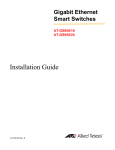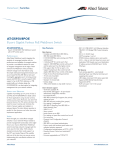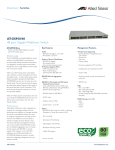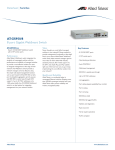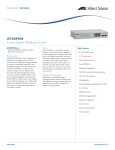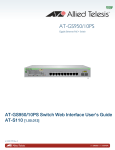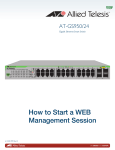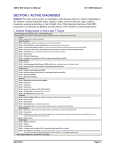Download Allied Telesis AT-S82 Installation guide
Transcript
Gigabit Ethernet WebSmart Switch AT-GS950/8 Installation Guide 613-000380 Rev. C Copyright © 2007 Allied Telesis, Inc. All rights reserved. No part of this publication may be reproduced without prior written permission from Allied Telesis, Inc. Allied Telesis is a trademark of Allied Telesis, Inc. Microsoft and Internet Explorer are registered trademarks of Microsoft Corporation. Netscape Navigator is a registered trademark of Netscape Communications Corporation. All other product names, company names, logos or other designations mentioned herein are trademarks or registered trademarks of their respective owners. Allied Telesis, Inc. reserves the right to make changes in specifications and other information contained in this document without prior written notice. The information provided herein is subject to change without notice. In no event shall Allied Telesis, Inc. be liable for any incidental, special, indirect, or consequential damages whatsoever, including but not limited to lost profits, arising out of or related to this manual or the information contained herein, even if Allied Telesis, Inc. has been advised of, known, or should have known, the possibility of such damages. Electrical Safety and Emissions Standards This product meets the following standards. U.S. Federal Communications Commission Radiated Energy Note: This equipment has been tested and found to comply with the limits for a Class A digital device pursuant to Part 15 of FCC Rules. These limits are designed to provide reasonable protection against harmful interference when the equipment is operated in a commercial environment. This equipment generates, uses, and can radiate radio frequency energy and, if not installed and used in accordance with this instruction manual, may cause harmful interference to radio communications. Operation of this equipment in a residential area is likely to cause harmful interference in which case the user will be required to correct the interference at his own expense. Note: Modifications or changes not expressly approved of by the manufacturer or the FCC, can void your right to operate this equipment. Industry Canada This Class A digital apparatus complies with Canadian ICES-003. Cet appareil numérique de la classe A est conforme à la norme NMB-003 du Canada. European Union Restriction of the Use of Certain Hazardous Substances (RoHS) in Electrical and Electronic Equipment This Allied Telesis RoHS-compliant product conforms to the European Union Restriction of the Use of Certain Hazardous Substances (RoHS) in Electrical and Electronic Equipment. Allied Telesis ensures RoHS conformance by requiring supplier Declarations of Conformity, monitoring incoming materials, and maintaining manufacturing process controls. RFI Emissions FCC Class A, EN55022 Class A, EN61000-3-2, EN61000-3-3, VCCI Class A, C-TICK, CE Warning: In a domestic environment this product may cause radio interference in which case the user may be required to take adequate measures. Immunity EN55024 Electrical Safety EN60950 (TUV), UL 60950 (CULUS) Laser Safety EN60825 3 Translated Safety Statements Important: The indicates that a translation of the safety statement is available in a PDF document titled “Translated Safety Statements” posted on the Allied Telesis website at www.alliedtelesis.com and on the documentation CD shipped with this product. 4 Contents Preface ................................................................................................................................................................................11 Safety Symbols Used in this Document................................................................................................................................12 Where to Find Web-based Guides .......................................................................................................................................13 Contacting Allied Telesis ......................................................................................................................................................14 Online Support ..............................................................................................................................................................14 Email and Telephone Support .......................................................................................................................................14 Warranty ........................................................................................................................................................................14 Returning Products........................................................................................................................................................14 For Sales or Corporate Information ...............................................................................................................................14 Chapter 1: Overview ..........................................................................................................................................................15 Features ...............................................................................................................................................................................16 Front and Back Panels .........................................................................................................................................................17 Ports .....................................................................................................................................................................................18 Twisted Pair Ports .........................................................................................................................................................18 SFP Ports ......................................................................................................................................................................18 LEDs .....................................................................................................................................................................................19 Power Supply .......................................................................................................................................................................21 Ethernet Switching Basics ....................................................................................................................................................22 MAC Address Table ......................................................................................................................................................22 Duplex Mode .................................................................................................................................................................23 Store and Forward.........................................................................................................................................................23 Back Pressure and Flow Control ...................................................................................................................................24 Network Topologies ..............................................................................................................................................................25 Power Workgroup Topology ..........................................................................................................................................25 Collapsed Backbone .....................................................................................................................................................25 Chapter 2: Installation .......................................................................................................................................................27 Reviewing Safety Precautions ..............................................................................................................................................28 Selecting a Site for the Switch ..............................................................................................................................................30 Cabling .................................................................................................................................................................................31 Unpacking the Switch ...........................................................................................................................................................32 Installing the Switch on a Desktop........................................................................................................................................33 Mounting the Switch on a Wall .............................................................................................................................................34 Installing the Switch in a Rack ..............................................................................................................................................36 Installing an Optional SFP Transceiver ................................................................................................................................38 Cabling and Powering On the Switch ...................................................................................................................................40 Connecting the Twisted Pair Cables .............................................................................................................................40 Connecting the Fiber Optic Cables ...............................................................................................................................40 Powering On the Switch ................................................................................................................................................41 Starting a Remote Management Session .............................................................................................................................43 Resetting the Switch .............................................................................................................................................................45 Chapter 3: Troubleshooting ..............................................................................................................................................47 Checking the LEDs ...............................................................................................................................................................48 Checking the POWER LED ...........................................................................................................................................48 Checking the L/A LED ...................................................................................................................................................48 Appendix A: Technical Specifications .............................................................................................................................49 Physical Specifications .........................................................................................................................................................49 Environmental Specifications................................................................................................................................................49 5 Contents Power Specifications.............................................................................................................................................................49 Safety and Electromagnetic Emissions Certifications...........................................................................................................49 Connectors and Port Pinouts ................................................................................................................................................50 6 Figures Figure 1. Front and Back Panels .........................................................................................................................................17 Figure 2. System and Port LEDs .........................................................................................................................................19 Figure 3. SFP LEDs.............................................................................................................................................................20 Figure 4. Power Workgroup Topology .................................................................................................................................25 Figure 5. Collapsed Backbone - Hub Topology ...................................................................................................................26 Figure 6. Attaching the Rubber Feet ...................................................................................................................................33 Figure 7. Installing the Plastic Anchors and Screws............................................................................................................34 Figure 8. Positioning the Switch (Switch Faces Down) .......................................................................................................35 Figure 9. Attaching the Rack-Mount Bracket (Switch is Flush with Rack) ...........................................................................36 Figure 10. Attaching the Rack-Mount Bracket (Switch Extends From Rack) ......................................................................36 Figure 11. Mounting the Switch on a Rack (Switch is Flush with Rack) ..............................................................................37 Figure 12. Mounting the Switch on a Rack (Switch Extends From Rack) ...........................................................................37 Figure 13. Removing the Dust Plugs ...................................................................................................................................38 Figure 14. Inserting the SFP Transceiver ............................................................................................................................39 Figure 15. Connecting the Twisted Pair Data Cables..........................................................................................................40 Figure 16. Removing the Dust Plug from the SFP Transceiver...........................................................................................41 Figure 17. Connecting the Fiber Optic Cable ......................................................................................................................41 Figure 18. Plugging in the AC Power Cord..........................................................................................................................41 Figure 19. Entering a Switch’s IP Address in the URL Field................................................................................................43 Figure 20. AT-S82 Software Login Page .............................................................................................................................44 Figure 21. AT-S82 Home Page ...........................................................................................................................................44 Figure 22. Resetting the Switch...........................................................................................................................................45 Figure 23. RJ-45 Connector and Port Pin Layout................................................................................................................50 7 Figures 8 Tables Table 1. Table 2. Table 3. Table 4. Table 5. Table 6. Table 7. Table 8. Safety Symbols .....................................................................................................................................................12 System LED ..........................................................................................................................................................19 10/100/1000Base-T Port LEDs .............................................................................................................................19 SFP Port LEDs .....................................................................................................................................................20 Twisted Pair Cabling and Distances .....................................................................................................................31 MDI Pin Signals (10Base-T or 100Base-TX) ........................................................................................................50 MDI-X Pin Signals (10Base-T or 100Base-TX) ....................................................................................................50 RJ-45 1000Base-T Connector Pinouts .................................................................................................................51 9 Tables 10 Preface This guide contains instructions on how to install the AT-GS950/8 Gigabit Ethernet WebSmart Switch. This preface contains the following sections: “Safety Symbols Used in this Document” on page 12 “Where to Find Web-based Guides” on page 13 “Contacting Allied Telesis” on page 14 11 Preface Safety Symbols Used in this Document This document uses the safety symbols defined in Table 1. Table 1. Safety Symbols Symbol 12 Meaning Description Caution Performing or omitting a specific action may result in equipment damage or loss of data. Warning Performing or omitting a specific action may result in electrical shock. AT-GS950/8 Gigabit Ethernet WebSmart Switch Installation Guide Where to Find Web-based Guides The installation and user guides for all Allied Telesis products are available in portable document format (PDF) on our web site at www.alliedtelesis.com. You can view the documents online or download them onto a local workstation or server. 13 Preface Contacting Allied Telesis This section provides Allied Telesis contact information for technical support as well as sales or corporate information. Online Support You can request technical support online by accessing the Allied Telesis Knowledge Base from the following web site: www.alliedtelesis.com/support. You can use the Knowledge Base to submit questions to our technical support staff and review answers to previously asked questions. Email and Telephone Support For Technical Support via email or telephone, refer to the Allied Telesis web site: www.alliedtelesis.com. Select your country from the list displayed on the website. Then select the appropriate menu tab. Warranty For warranty information, refer to the Allied Telesis web site: www.alliedtelesis.com/warranty. Returning Products Products for return or repair must first be assigned a Return Materials Authorization (RMA) number. A product sent to Allied Telesis without a RMA number will be returned to the sender at the sender’s expense. To obtain an RMA number, contact the Allied Telesis Technical Support group at our web site: www.alliedtelesis.com/support/rma. Select your country from the list displayed on the website. Then select the appropriate menu tab. For Sales or Corporate Information 14 You can contact Allied Telesis for sales or corporate information at our web site: www.alliedtelesis.com. Select your country from the list displayed on the website. Then select the appropriate menu tab. Chapter 1 Overview The AT-GS950/8 Gigabit Ethernet WebSmart Switch is a Layer 2 Gigabit Ethernet switch that is designed to simplify the task of creating or expanding an Ethernet, Fast Ethernet, or Gigabit Ethernet network. This chapter contains the follows sections: “Features” on page 16 “Front and Back Panels” on page 17 “Ports” on page 18 “LEDs” on page 19 “Power Supply” on page 21 “Ethernet Switching Basics” on page 22 “Network Topologies” on page 25 15 Chapter 1: Overview Features The AT-GS950/8 Gigabit Ethernet WebSmart Switch includes the following features: 16 Eight Auto-Negotiating 10/100/1000Base-T twisted pair ports with RJ-45 connectors Two small form-factor pluggable (SFP) ports LEDs for unit and port status Auto MDI/MDI-X on the twisted pair ports IEEE 802.3, IEEE 802.3u compliant, IEEE 802.3z compliant, IEEE 802.3ab compliant IEEE 802.3x flow control in full-duplex operation (back pressure supported in half-duplex operation) Store and forward switching mode MAC address table capacity of up to 4K addresses with automatic aging Web-based configuration using the AT-S82 Management Software AT-GS950/8 Gigabit Ethernet WebSmart Switch Installation Guide Front and Back Panels Figure 1 shows the front and back panels of the AT-GS950/8 switch. 912 System (Power) LED Port LEDs Recessed Reset Button 10/100/1000Base-T Twisted Pair Ports SFP Ports SFP Port LEDs 100-240VAC DEFAULT WEB MANAGEMENT PARAMETERS IP Address: 192.168.1.1 Subnet Mask: 255.255.255.0 AC Power Connector 913 Figure 1. Front and Back Panels 17 Chapter 1: Overview Ports The AT-GS950/8 switch features eight twisted pair ports and two SFP ports. See the following sections for descriptions of the ports. Twisted Pair Ports The twisted pair ports feature 8-pin RJ-45 copper connectors. (For the port pinouts, refer to “Connectors and Port Pinouts” on page 50.) The ports are 10Base-T, 100Base-TX, and 1000Base-T compliant and are capable of 10 megabits per second (Mbps), 100 Mbps, and 1000 Mbps speeds. In addition, the twisted pair ports are IEEE 802.3u Auto-Negotiation compliant. With Auto-Negotiation, the switch automatically matches the highest possible common speed between each switch port and each end node. For example, if an end node is capable of only 10 Mbps, the switch sets the port connected to the end node to 10 Mbps. Each twisted pair port can operate in either half- or full-duplex mode. The twisted pair ports are IEEE 802.3u-compliant and Auto-Negotiate the duplex mode setting. Note For the switch to set the duplex mode for each port correctly, the end nodes that you connect to the switch ports must also use AutoNegotiation. Otherwise, a duplex mode mismatch can occur, affecting network performance. For further information, refer to “Duplex Mode” on page 23. Each twisted pair port has a maximum operating distance of 100 m (328 feet). For 10 Mbps operation, Category 3 or better 100 ohm shielded or unshielded twisted pair cabling is required. For 100 or 1000 Mbps operation, Category 5 and Enhanced Category 5 (5E) 100 ohm shielded or unshielded twisted pair cabling is required. The twisted pair ports are auto-MDI. Consequently, they automatically configure themselves as either MDI or MDI-X. This feature allows you to use either straight-through or crossover twisted pair cables to connect devices to the ports. SFP Ports 18 The two SFP ports can operate in place of their twisted pair port equivalents to provide fiber optic connectivity. When an SFP is inserted in the SFP ports (7 or 8) and a fiber optic cable is connected to ports 7/7R or 8/8R, the corresponding twisted pair port is disabled. AT-GS950/8 Gigabit Ethernet WebSmart Switch Installation Guide LEDs The LEDs on the front panel display system and port status information. The system and port LEDs are show in Figure 2 and described in Table 2 and Table 3. 914 System (Power) LED Port LEDs Figure 2. System and Port LEDs Table 2. System LED LED State Description POWER Off The switch is not receiving power. On The switch is receiving power. Table 3. 10/100/1000Base-T Port LEDs LED State Description L/A (LINK/ACT) Off The port has not established a link with an end node. Blinking Green The port is transmitting or receiving data. Green A valid link has been established on the port. SPD (SPEED) On The port is operating at 1000 Mbps. Off The port is operating at 10/100 Mbps or no link is established. DPX Off Indicates half-duplex mode. On Indicates full-duplex or no connection. 19 Chapter 1: Overview The SFP LEDs are shown in Figure 3 and described in Table 4. 930 Figure 3. SFP LEDs. Table 4. SFP Port LEDs LED State Description In Use (port 7) Off The port has not established a link with an end node. Blinking Green The port is transmitting or receiving data. Green A valid link has been established on the port. Off The port has not established a link with an end node. Blinking Green The port is transmitting or receiving data. Green A valid link has been established on the port. In Use (port 8) 20 AT-GS950/8 Gigabit Ethernet WebSmart Switch Installation Guide Power Supply The switch has an internal power supply with a single AC power connector on the back panel. This connector features autoswitch AC inputs. To power the switch on or off, connect or disconnect the power cord provided with the switch. Note For the power requirements, refer to “Power Specifications” on page 49. 21 Chapter 1: Overview Ethernet Switching Basics An Ethernet switch interconnects network devices, such as workstations, printers, routers, and other Ethernet switches, so that they can communicate with each other by sending and receiving Ethernet frames. MAC Address Table Every hardware device on your network has a unique MAC address. This address is assigned to the device by the device’s manufacturer. For example, when you install a Network Interface Card (NIC) in a computer so that you can connect it to the network, the NIC already has a MAC address assigned to it by its manufacturer. The MAC address table in the AT-GS950/8 switch can store up to 4K of MAC addresses. The switch uses the table to store the MAC addresses of the network end nodes connected to the ports, along with the port number on which each address was learned. A switch learns the MAC addresses of the end nodes by examining the source address of each packet received on a port. It adds the address and port on which the packet was received to the MAC table (if the address is not already entered in the table). The result is a table that contains all the MAC addresses of the devices that are connected to the switch’s ports and the port number where each address was learned. When the switch receives a packet, it also examines the destination address and, by referring to its MAC address table, determines the port on which the destination end node is connected. It then forwards the packet to the appropriate port and on to the end node. This increases network bandwidth by limiting each frame to the appropriate port when the intended end node is located, freeing the other switch ports for receiving and transmitting data. If the switch receives a packet with a destination address that is not in the MAC address table, it floods the packet to all the ports on the switch. If the ports have been grouped into virtual LANs, the switch floods the packet only to those ports which belong to the same VLAN as the port on which the packet was received. This prevents packets from being forwarded to inappropriate LAN segments, decreasing network security. When the destination end node responds, the switch adds its MAC address and port number to the table. If the switch receives a packet with a destination address that is on the same port on which the packet was received, it discards the packet without forwarding it on to any port. Since both the source end node and the destination end node for the packet are located on the same port, there is no reason for the switch to forward the packet. 22 AT-GS950/8 Gigabit Ethernet WebSmart Switch Installation Guide Duplex Mode The term duplex mode refers to how an end node receives and transmits data. If an end node can receive or transmit data, but not both simultaneously, the end node is operating in half-duplex mode. If an end node can both receive and transmit data simultaneously, the end node is operating in full-duplex mode. Naturally, an end node capable of operating in full-duplex can handle data much faster than an end node that can only operate in half-duplex mode. The twisted pair ports on the AT-GS950/8 switch can operate in either half-or full-duplex mode. They are IEEE 802.3u-compliant and use AutoNegotiation to set the duplex mode setting for you automatically. For Auto-Negotiation to operate properly on a switch, the end nodes connected to the switch should also use Auto-Negotiation. If an end node does not have this feature and has a fixed duplex mode of full-duplex, the result is a duplex mode mismatch between the end node and a switch port. A port on the Gigabit Ethernet switch connected to an end node with a fixed duplex mode of full-duplex will operate at only half-duplex. This results in the end node using full-duplex and the switch port using halfduplex. This can produce network performance problems. If you encounter this situation, you must configure the port on the end node to use AutoNegotiation or, if it lacks that feature, to half-duplex. Note Because the ports on the AT-GS950/8 switch operate in AutoNegotiate mode only, the end nodes connected to the switch must also be configured to operate in the Auto-Negotiate mode. If an end node is configured to a specific duplex in a manual mode, it will not respond to the Auto-Negotiate protocol from the AT-GS950/8 switch. (Since the speed is determined from the link pulses, the speed is always detected correctly.) As a result, the port setting on the switch becomes half-duplex. If the end node is manually configured to fullduplex, there is a duplex mismatch and data is lost. If the end node is manually configured to half-duplex, both ports have the speed and duplex match up correctly. Store and Forward The AT-GS950/8 switch uses store and forward as the method for receiving and transmitting frames. When a Ethernet frame is received by a switch port, the switch does not retransmit the frame from the destination port until it has received the entire frame and stored the frame in a port buffer. Then it examines the frame to determine if it is a valid frame. Invalid frames, such as fragments or runts, are discarded by the switch. This ensures that only valid frames are transmitted from the switch ports and that damaged frames are not propagated on your network. 23 Chapter 1: Overview Back Pressure and Flow Control To maintain the orderly movement of data between the end nodes, an Ethernet switch may periodically need to signal an end node to stop sending data. This can occur under several circumstances. For example, if two end nodes are operating at different speeds, the switch, while transferring data between the end nodes, instructs the faster end node to stop transmitting data to allow the slower end node to catch up. An example of this occurs when a server operating at 100 Mbps is sends data to a workstation operating at only 10 Mbps. The method a switch signals an end node to stop transmitting data differs depending on the speed and duplex mode of the end node and switch port. A twisted pair port operating at 100 Mbps and half-duplex mode forces a collision to stop an end node from transmitting data. A collision on an Ethernet network occurs when two end nodes attempt to transmit data using the same data link at the same time. A collision causes end nodes to stop sending data. When the switch needs to stop a 100 Mbps, half-duplex end node from transmitting data, it forces a collision on the data link, which stops the end node. When the switch is ready to receive data again, the switch stops forcing collisions. This is referred to as back pressure. A port operating at 100 Mbps and full-duplex mode uses PAUSE frames, as specified in the IEEE 802.3x standard, to stop the transmission of data from an end node. Whenever the switch wants an end node to stop transmitting data, it issues this frame. The frame instructs the end node to cease transmission. The switch continues to issue PAUSE frames until it is ready again to receive data from the end node. This is referred to as flow control. The AT-GS950/8 switch supports both TX and RX flow control. 24 AT-GS950/8 Gigabit Ethernet WebSmart Switch Installation Guide Network Topologies This section describes two network topologies that you can create with the AT-GS950/8 switch: a power workgroup and collapsed backbone. Both types of topologies are described below. Power Workgroup Topology The topology shown in Figure 4 is commonly referred to as a power workgroup topology. Each workstation or end node is connected directly to a port on the AT-GS950/8 switch. Each end node has a dedicated data link to the switch for the best performance and reliability results. The devices can operate at 100 Mbps or 1000 Mbps. 915 Legend 100 Mbps 1000 Mbps Figure 4. Power Workgroup Topology Collapsed Backbone In the topology illustrated in Figure 5, an AT-GS950/8 switch connects three Fast Ethernet switches that have Gigabit Ethernet uplinks. This type of topology is often referred to as a collapsed backbone topology. In this topology, the AT-GS950/8 switch functions as the focal point of the network and transfers an Ethernet frame between the Fast Ethernet switches only when the destination end node for the frame is on a different switch than the end node that originated the frame. This topology reduces the amount of unnecessary data traffic in each workgroup, freeing up bandwidth and improving network performance. 25 Chapter 1: Overview Figure 5. Collapsed Backbone - Hub Topology AT-GS900/8E Switch AT-GS900/16 Switch AT-GS900/24 Switch 916 Legend 100 Mbps 1000 Mbps 26 Chapter 2 Installation This chapter contains the following sections: “Reviewing Safety Precautions” on page 28 “Selecting a Site for the Switch” on page 30 “Cabling” on page 31 “Unpacking the Switch” on page 32 “Installing the Switch on a Desktop” on page 33 “Mounting the Switch on a Wall” on page 34 “Installing the Switch in a Rack” on page 36 “Installing an Optional SFP Transceiver” on page 38 “Cabling and Powering On the Switch” on page 40 “Starting a Remote Management Session” on page 43 “Resetting the Switch” on page 45 27 Chapter 2: Installation Reviewing Safety Precautions Please review the following safety precautions before you begin to install the chassis or any of its components. Note The indicates that a translation of the safety statement is available in a PDF document titled “Translated Safety Statements” on the Allied Telesis website at www.alliedtelesis.com and also on the documentation CD shipped with this product. Warning: To prevent electric shock, do not remove the cover. No user-serviceable parts inside. This unit contains hazardous voltages and should only be opened by a trained and qualified technician. To avoid the possibility of electric shock, disconnect electric power to the product before connecting or disconnecting the LAN cables. E1 Warning: Do not work on equipment or cables during periods of lightning activity. E2 Warning: Power cord is used as a disconnection device. To deenergize equipment, disconnect the power cord. E3 Warning: Class I Equipment. This equipment must be earthed. The power plug must be connected to a properly wired earth ground socket outlet. An improperly wired socket outlet could place hazardous voltages on accessible metal parts. E4 Pluggable Equipment. The socket outlet shall be installed near the equipment and shall be easily accessible. E5 Caution: Air vents must not be blocked and must have free access to the room ambient air for cooling. E6 Warning: Operating Temperature. This product is designed for a maximum ambient temperature of 40° degrees C. E7 All Countries: Install product in accordance with local and National Electrical Codes. E8 28 AT-GS950/8 Gigabit Ethernet WebSmart Switch Installation Guide Circuit Overloading: Consideration should be given to the connection of the equipment to the supply circuit and the effect that overloading of circuits might have on overcurrent protection and supply wiring. Appropriate consideration of equipment nameplate ratings should be used when addressing this concern. E21 Warning: Mounting of the equipment in the rack should be such that a hazardous condition is not created due to uneven mechanical loading. E25 If installed in a closed or multi-unit rack assembly, the operating ambient temperature of the rack environment may be greater than the room ambient temperature. Therefore, consideration should be given to installing the equipment in an environment compatible with the manufacturer’s maximum rated ambient temperature (Tmra). E35 Caution: Installation of the equipment in a rack should be such that the amount of air flow required for safe operation of the equipment is not compromised. E36 Warning: Reliable earthing of rack-mounted equipment should be maintained. Particular attention should be given to supply connections other than direct connections to the branch circuits (e.g., use of power strips). E37 29 Chapter 2: Installation Selecting a Site for the Switch Observe the following requirements when choosing a site for your switch: 30 If you plan to install the switch in an equipment rack, ensure that the rack is safely secured and that it will not tip over. Devices in a rack should be installed starting at the bottom, with the heavier devices near the bottom of the rack. If you are installing the switch on a table, ensure that the table is level and secure. The power outlet for the switch should be located near the unit and should be easily accessible. The site should provide for easy access to the ports on the front of the switch. This will make it easy for you to connect and disconnect cables, as well as view the switch’s LEDs. To allow proper cooling of the switch, air flow around the unit and through its vents on the side and rear should not be restricted. Do not place objects on top of the switch. Do not expose the switch to moisture or water. Ensure that the site is a dust-free environment. You should use dedicated power circuits or power conditioners to supply reliable electrical power to the network devices. AT-GS950/8 Gigabit Ethernet WebSmart Switch Installation Guide Cabling Table 5 contains the cabling specifications for the twisted pair ports. Table 5. Twisted Pair Cabling and Distances Speed Type of Cable Maximum Operating Distance 10 Mbps Category 3 or better 100-ohm shielded or unshielded twisted pair cable 100 m (328 ft) 100 Mbps Category 5 or Category 5E (Enhanced) 100-ohm shielded or unshielded twisted pair cable 100 m (328 ft) 1000 Mbps Category 5 and Category 5E (Enhanced) 100-ohm shielded or unshielded twisted pair cable 100 m (328 ft) Note The twisted pair ports on the switch feature auto-MDI when operating at 10, 100 or 1000 Mbps. Each port is automatically configured as MDI or MDI-X when connected to an end node. Consequently, you can use either a straight-through or crossover twisted pair cable when connecting any network device to a twisted pair port on the switch. 31 Chapter 2: Installation Unpacking the Switch To unpack the switch, perform the following procedure: 1. Remove all components from the shipping package. Note Store the packaging material in a safe location. You must use the original shipping material if you need to return the unit to Allied Telesis. 2. Place the switch on a level, secure surface. 3. Ensure that the following hardware components are included in the package: Two rack-mount brackets Eight rack-mount bracket screws (black) Four wall-mounting screws (stainless steel) Four plastic anchors (for wall-mounting) Four rubber feet (for desktop use) One power cord Documentation CD If any item is missing or damaged, contact your Allied Telesis sales representative for assistance. 32 AT-GS950/8 Gigabit Ethernet WebSmart Switch Installation Guide Installing the Switch on a Desktop To install the switch on a desktop, perform the following procedure: 1. Remove all equipment from the package and store the packaging material in a safe place. 2. Turn the switch over and attach the four rubber feet to the bottom of the switch as shown in Figure 6. 917 Figure 6. Attaching the Rubber Feet 3. Turn the switch over again and place it on a flat, secure surface (such as a desk or table) leaving ample space around the unit for ventilation. To cable and power on the switch, see “Cabling and Powering On the Switch” on page 40. 33 Chapter 2: Installation Mounting the Switch on a Wall To mount the AT-GS950/8 switch on a wall, perform the following procedure: 1. If the rubber feet are attached, turn over the switch and remove the rubber feet using a flat-head screwdriver. 2. Select a wall location for the device. 3. Choose one of the following: For drywall installation, drill two 1/8-inch holes that are 5 3/8 inches apart. Insert the plastic anchors. Tap the anchors flush with the wall. For installation into a wood surface, two 1/8-inch holes that are 5 3/8 inches apart. Note Plastic anchors are not used for installation into a wood surface. 4. Insert two stainless steel screws that are included with the switch as shown in Figure 7. 912 Figure 7. Installing the Plastic Anchors and Screws 5. Tighten the screws, leaving 1/4-inch of the thread exposed. 6. Position the switch so the key holes face the wall. 34 AT-GS950/8 Gigabit Ethernet WebSmart Switch Installation Guide The front of the switch faces the floor as shown in Figure 8. 921 Figure 8. Positioning the Switch (Switch Faces Down) To cable and power on the switch, see “Cabling and Powering On the Switch” on page 40. 35 Chapter 2: Installation Installing the Switch in a Rack To install the AT-GS950/8 switch in a rack, perform the following procedure: 1. If rubber feet are attached, remove them using a flat-head screwdriver. 2. Install a rack-mount bracket on one side of the switch using a Phillips screwdriver and four of the rack-mount screws included with the switch. There are two ways to attach the brackets to the chassis. Attach the brackets so the switch is flush with the front of the rack as shown in Figure 9. Or, attach the brackets so the switch extends in front of the rack as shown in Figure 10. 918 Figure 9. Attaching the Rack-Mount Bracket (Switch is Flush with Rack) 931 Figure 10. Attaching the Rack-Mount Bracket (Switch Extends From Rack) 3. Repeat step 2 to attach the remaining bracket to the other side of the switch. 4. Mount the switch on a 19-inch rack using the two of the large screws included with the package. 36 AT-GS950/8 Gigabit Ethernet WebSmart Switch Installation Guide Figure 11 shows how to mount the switch so that it is flush with the rack, and Figure 12 shows to mount the switch so that it extends in front of the rack. 919 Figure 11. Mounting the Switch on a Rack (Switch is Flush with Rack) 932 Figure 12. Mounting the Switch on a Rack (Switch Extends From Rack) 5. Repeat step 4 to attach the switch to the other side of the rack. To cable the switch, see “Cabling and Powering On the Switch” on page 40. 37 Chapter 2: Installation Installing an Optional SFP Transceiver The AT-GS950/8 switch has two SFP uplink ports on the front of the switch. To install an SFP transceiver, perform the following procedure: Note You must install the SFP transceiver before you connect cables to it. Note The transceiver can be hot-swapped; you do not need to power off the switch to install a transceiver. However, always remove the cables before removing the transceiver. 1. Remove the transceiver from its shipping container and store the packaging material in a safe location. Warning An SFP transceiver can be damaged by static electricity. Be sure to observe all standard electrostatic discharge (ESD) precautions, such as wearing an antistatic wrist strap, to avoid damaging the transceiver. 2. Remove the dust plugs from the SFP slots, as shown in Figure 13. 922 Figure 13. Removing the Dust Plugs 3. Locate the label on the transceiver and turn it so that the label is on top and the alignment groove is on the bottom. 38 AT-GS950/8 Gigabit Ethernet WebSmart Switch Installation Guide 4. Slide the SFP transceiver into an SFP slot on the switch, as shown in Figure 14. 923 Figure 14. Inserting the SFP Transceiver 5. Repeat steps 2 through 4 if you are installing another SFP transceiver. Note SFP transceivers are dust sensitive. When a fiber optic cable is not installed, or when you store the SFP transceiver, keep the plug in the optical bores. When you do remove the plug, keep it for future use. Note Unnecessary removal and insertion of an SFP transceiver can lead to premature failure. For information about cabling the SFP transceiver, consult the documentation that was shipped with the SFP transceiver. 39 Chapter 2: Installation Cabling and Powering On the Switch To cable and power on the AT-GS950/8 switch, see the following sections: Connecting the Twisted Pair Cables “Connecting the Twisted Pair Cables” on page 40 “Connecting the Fiber Optic Cables” on page 40 “Powering On the Switch” on page 41 To connect the twisted cables to the RJ-45 ports on the AT-GS950/8 switch, perform the following procedure: 1. Plug the twisted pair data cables to the RJ-45 ports on the switch, as shown in Figure 15. 924 Figure 15. Connecting the Twisted Pair Data Cables When you connect a twisted pair cable to a port, observe the following guidelines: An RJ-45 connector should fit snugly into the port on the switch. The tab on the connector should lock the connector into place. The ports on the switch are auto-MDI/MDI-X. You can use either a straight-through or crossover twisted pair cable to connect any type of network device to a port on the switch. The network should not contain data loops, which can adversely affect network performance. A data loop exists when two or more network devices can communicate with each other over more than one data path. 2. Connect the other end of the twisted pair cable to a port in the end node. Connecting the Fiber Optic Cables 40 To connect a fiber optic cable to an SFP transceiver installed in the AT-GS950/8 switchS, perform the following procedure: 1. Remove the dust plug from the SFP transceiver, as shown in AT-GS950/8 Gigabit Ethernet WebSmart Switch Installation Guide Figure 16. 925 Figure 16. Removing the Dust Plug from the SFP Transceiver 2. Connect the fiber optic cable to the SFP port, as shown in Figure 17. 926 Figure 17. Connecting the Fiber Optic Cable Powering On the Switch To power on the switch, perform the following procedure: 1. Plug the power cord into the AC power connector on the back of the switch, as shown in Figure 18. 927 Figure 18. Plugging in the AC Power Cord 41 Chapter 2: Installation 2. Plug the other end of the power cord into a wall outlet. Warning: Power cord is used as a disconnection device. To deenergize equipment, disconnect the power cord. E3 Pluggable Equipment. The socket outlet shall be installed near the equipment and shall be easily accessible. E5 3. Verify that the POWER LED is green. If the LED is OFF, refer to “Checking the POWER LED” on page 48. The switch is now powered on and ready for network operations. To start a remote management session on the switch, refer to “Starting a Remote Management Session” on page 43. 42 AT-GS950/8 Gigabit Ethernet WebSmart Switch Installation Guide Starting a Remote Management Session To establish a web browser management session with an AT-GS950/8 switch, the switch has an assigned an IP address. If the switch is part of an enhanced stack, such as a slave switch, start the web browser management session on the stack’s master switch. After you have started the session, you can access and manage all of the switches in the stack from the master switch. Note For more information about the AT-S82 software, see the AT-S82 Management Software User’s Guide. To start a web browser management session, perform the following procedure: 1. Start your web browser. Note If your PC with the web browser is on the same side of a firewall as the switch, you must configure your browser’s network options to not allow proxies. Consult your web browser’s documentation. 2. Enter the default IP address, 192.168.1.1, of the AT-GS950/8 switch in your web browser. See Figure 19. Switch’s IP Address Figure 19. Entering a Switch’s IP Address in the URL Field 43 Chapter 2: Installation The AT-S82 login page is displayed, as shown in Figure 20. Figure 20. AT-S82 Software Login Page 3. Enter a user name and password. For manager access, enter “manager” as the user name. The default password is “manager.” Login names and passwords are casesensitive. You cannot change the default user name. To change the password, refer to the AT-S82 Management Software User’s Guide. The AT-S82 home page is shown in Figure 21. Figure 21. AT-S82 Home Page 44 AT-GS950/8 Gigabit Ethernet WebSmart Switch Installation Guide Resetting the Switch A recessed reset button is available for you to reset the switch. You may need to reset the switch after you upgrade the AT-S82 software. The reset button is located on the front of the switch. To reset the system, perform the following procedure: 1. Locate the reset button on the front of the switch. 2. Press the reset button with the tip of a pen as shown in Figure 22. 929 Figure 22. Resetting the Switch The switch runs some diagnostic tests. After the diagnostic tests are complete, the switch reloads the AT-S82 software. The entire reset process takes about 30 seconds to complete. 45 Chapter 2: Installation 46 Chapter 3 Troubleshooting This chapter contains information on how to troubleshoot the switch in the event that a problem occurs. It contains the following section: “Checking the LEDs” on page 48 Note If you need further assistance, please contact Allied Telesis Technical Support. Refer to “Contacting Allied Telesis” on page 14. 47 Chapter 3: Troubleshooting Checking the LEDs This section describes how to troubleshoot the AT-GS950/8 switch using the POWER and L/A LEDs. Checking the POWER LED Checking the L/A LED Check the POWER LED on the front of the switch. If the LED is off, indicating that the unit is not receiving power, do the following: Ensure that the power cord is securely connected to the power source and to the AC connector on the back panel of the switch. Verify that the power outlet has power by connecting another device to it. Connect the unit to another power source. Replace the power cord. Verify that the voltage from the power source is within the required levels for your region. Verify that the L/A LED for each port is ON. If a L/A LED is OFF, do the following: Verify that the end node connected to the port is powered on and is operating properly. Verify that the twisted pair cable is securely connected to the port on the switch and to the port on the end node. Ensure that the twisted pair cable does not exceed 100 meters (328 feet). Verify that you are using the appropriate category of twisted pair cable: Category 3 or better for 10 Mbps operation and Category 5 and Category 5E for 100 and 1000 Mbps operation. Note A 1000Base connection may require five to ten seconds to establish a link. 48 Appendix A Technical Specifications Physical Specifications Dimensions: 280 mm x 43 mm x 179 mm (W x D x H) (11.02 in x 1.69 in x 7.04 in) Weight: 1.61 kg (3.5 lbs) Environmental Specifications Operating Temperature: 0° C to 40° C (32° F to 104° F) Storage Temperature: -25° C to 70° C (-13° F to 158° F) Operating Humidity: 5% to 90% non-condensing Storage Humidity: 5% to 95% non-condensing Operating Altitude Range: Up to 3,000 m (9,843 ft) Power Specifications Input Supply Voltage: 100 - 240 VAC Power Consumption: 18 W Safety and Electromagnetic Emissions Certifications EMI/RFI: FCC Class A, EN55022 Class A, C-TICK Immunity: EN55024 Electrical Safety: EN60950-1, UL60950-1 (cULus) 49 Appendix A: Technical Specifications Quality and Reliability: MTBF (calculated with Telcordia standards) 270,000 hours Laser Safety EN60825 Connectors and Port Pinouts This section lists the connectors and connector pinouts for the AT-GS950/8 switch. Figure 23 illustrates the pin layout for an RJ-45 connector and port. 8 1 8 1 Figure 23. RJ-45 Connector and Port Pin Layout Table 6 lists the RJ-45 pin signals when a twisted pair port is operating in the MDI configuration. Table 6. MDI Pin Signals (10Base-T or 100Base-TX) Pin Signal 1 TX+ 2 TX- 3 RX+ 6 RX- Table 7 lists the RJ-45 port pin signals when a twisted pair port is operating in the MDI-X configuration. Table 7. MDI-X Pin Signals (10Base-T or 100Base-TX) Pin 50 Signal 1 RX+ 2 RX- 3 TX+ 6 TX- AT-GS950/8 Gigabit Ethernet WebSmart Switch Installation Guide Table 8 lists the RJ-45 connector pins and their signals when a 1000Base-T port is operating at 1000 Mbps. Table 8. RJ-45 1000Base-T Connector Pinouts Pin Pair Signal 1 1 TX and RX+ 2 1 TX and RX- 3 2 TX and RX+ 4 3 TX and RX+ 5 3 TX and RX- 6 2 TX and RX- 7 4 TX and RX+ 8 4 TX and RX- 51 Appendix A: Technical Specifications 52





















































